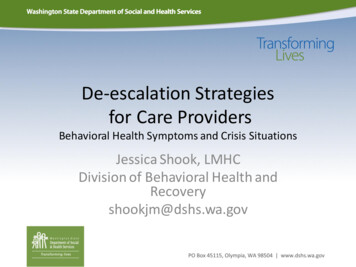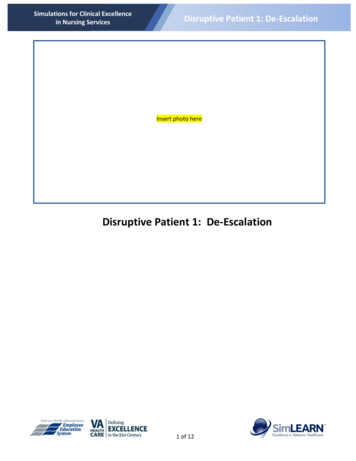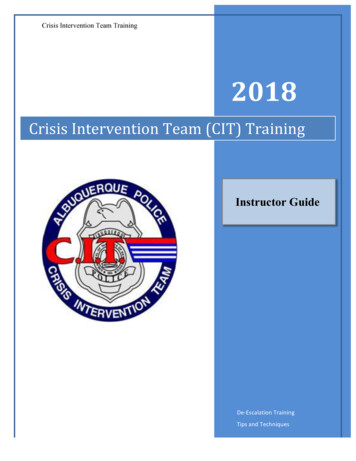
Transcription
De-escalation Strategiesfor Care ProvidersBehavioral Health Symptoms and Crisis SituationsJessica Shook, LMHCDivision of Behavioral Health andRecoveryshookjm@dshs.wa.gov
Learning Objectives Self awareness and self control How do we influence behavior? Understanding and responding tobehaviors and symptoms Supportive interventions
Behavioral Health In Our Community 1 in 4 adults in the United Statesexperiences mental illness in a givenyear 1 in 17 adults has a serious, chronicmental health disorder such asSchizophrenia, Bipolar Disorder, orMajor Depressive Disorder (National Alliance onMental Illness, March 2013) In 2009, 23.5 million people (9.3% ofpopulation 12 years of age and older)needed treatment for a substance usedisorder (SAMHSA National Survey on Drug Use and Health)
Self Awareness In any situation, the onlything you have completecontrol over is yourself We work in a profession that provides care forindividuals who will experience crisis Successful de-escalation begins with us – ourattitudes, beliefs, and actions
Personal Feelings Impact Care andCommunication Transference andCounter-transference– An individual’s positive ornegative feelings associated withanother person or a pastexperience may be transferredonto us– We may project our own positiveor negative feelings from pastexperiences onto the individual
Self Awareness What are my triggers and buttons?– This person is challenging what I love or hate– This person is violating my sense of morality
Under and Over Reaction Failure to protect the safety Destructive attitudes orof an individual throughactionsinaction Withdrawal of a caring Failure to set verbal, physicalmanner toward an individuallimits due to fear, avoidance, A physical intervention thator other reasonshurts an individual A punitive reaction
Self Control I don’t have to get intoa power struggle I don’t have to giveback what I get It’s not personal I know what mytriggers are
How Can I be Proactive? Be aware of your Internal Self– Biases, beliefs, moods– Reaction to stress Be aware of your Environment– Location, proximity, potential weapons Be aware of the Other Person– Notice and respond to cues about emotion andbehavior
Understanding Behaviors Everyone has thoughts, feelings, and needs We are more impulsive when we are in crisisPeople may not realize they are out of controlBehaviors are a way to get needs metWe need to match our interventions to theneeds behind the behaviors
Identifying and Responding toBehaviors What is the need behind the behavior?– FEAR– MANIPULATION– FRUSTRATION– INTIMIDATION
FEAR How do they look?– Freeze, cower, hide– Tense posture– Fight or flight mode
Reducing Fear Helping the person feel safe– Stay relaxed with your hands in full view– Stand slightly off to the side and far enough awaythat you do not appear to pose a physical threatto the person– Keep your voice soft and low– Use short phrases, 5 words or less– Explain your actions before you take them
Not thisTry this
MANIPULATION Person may make an initially calm request thatcannot be granted Statements and behaviors designed toprovoke a response Promote confusion
Working Through Manipulation Stay relaxed and assume a closed posture Turn slightly away, but do not turn your back Display subtle gestures of disinterest ordisapproval Avoid direct eye contact, instead look at theirshoulders, hairline, or chin Keep your voice low Respond like a broken record, or minimizeresponse
NoYes
FRUSTRATION Tense posture Fixed, focus glare Large, clenched gestures
Reducing Frustration Helping the person regain control– Square your shoulders, keep your back straightand your chin up– Keep hands visible, with palms out– Stay out of striking range– Maintain eye contact and focus on the personwhen you speak– Keep your words clear and voice low– Stick to repetitive directives of 5 words or less
Not thisDo this
INTIMIDATION Presents as physically menacing Clear demands that cannot be granted Threats of physical assault
Defusing Intimidation Maintain safety– Be relaxed but ready, do not appear fearful– Have an escape route– Do not use large gestures– Keep your voice emotionless and matter-of-fact– Your speech should be clear with directstatements– Make eye contact sparingly, do not stare
Not thisDo this instead
Identifying and Responding toSymptomsPersonality Post-Traumatic StressDementiaTraumatic Brain Injury
Personality Disorders Anger, depression, anxiety, mood swings Sensitivity to rejection, criticism,abandonment Easily overwhelmed, frustrated, and agitated Difficulty tolerating distress Behaviors to elicit care,attention, validation fromothers
Response Plan: Personality Disorders Avoid power struggles Limit emotionally charged responses Avoid threats, ultimatums, or excessiverestrictions Remain matter-of-fact and neutral Give realistically available choices as often aspossible Check back in with the person often
Mania/Hypomania Extreme mood swings andbehaviors Euphoric, energized,expansive, overconfident Feeling ‘invincible’ to harmand superior to others Labile, anxious, guarded Impatient, easily frustrated Confusion as to why othersare concerned
Response Plan: Mania/Hypomania Plan for unpredictabilityLow stimulus levelKeep directions short and simpleDon’t argueSay “you’re right” as much as possible
Psychosis Hallucinations and delusions May respond to auditoryhallucinations Hyper-vigilant, fearful, selfprotective Religious preoccupation Withdrawn, inward focus Self-harm or suicidality inresponse to commandhallucinations
Response Plan: Psychosis Approach slowly with non-threatening bodylanguage Ask them what they need Don’t contradict or argue about their beliefs Keep stimulus low in the environment
DepressionFeeling overwhelmed, hopeless, helplessChange/loss of perspectiveMultiple life stressorsSuicidal ideationMay or may not have identifiable emotionsbut feel “empty” or “blank”
Response Plan: Depression Ask what they need, explain what you can dofor them Avoid excessive restrictions Be kind and reassuring Explain what is happening Connect with family, friends, social resourcesfor acute support and additional resource
Anxiety Irritability, distractibility Feelings of dread Overwhelmed withthoughts and emotions Difficulty making decisionsand processing information Panic attacks Self medication with alcoholor drugs
Response Plan: Anxiety Treat physical symptoms as real Be reassuring, provide information aboutwhat will happen next Ask what would be most helpful to them Ask what has worked in the past Discuss recent and current situation in brief,neutral way
Post-Traumatic Stress Depression, hopelessness, helplessnessAnxietyIrritability, outbursts of angerDifficulty sleeping, concentratingSuicidal thoughts and actionsHypervigilanceFlashbacksSelf medication with alcohol or drugs
Response Plan: Post-Traumatic Stress Give spaceReduce external stimuliAnticipate and ask about triggersAsk what would be most helpful to themAsk what has worked for them in the pastInvolve family, friends, support network
Dementia Confusion, disorientation Poor memory Irritability, rapid moodchanges Anxiety Aggression resulting fromconfusion or fear Vulnerability to medicalcomplications
Response Plan: Dementia Create a calm environmentSpeak slowly, take your timeBe reassuring and provide comfortAsk permissionAsk what would be most helpful to them
Traumatic Brain Injury HeadacheDifficulty concentratingMemory impairmentsAttention deficitsMood swings and emotional disturbanceEasily frustratedImpaired cognitive functionsDifficulty with speech or communicationImpulsivityAgitation and restlessnessHallucinations
Response Plan: Traumatic Brain Injury Anticipate confusion and reactivity Speak briefly and clearly Direct attention away from confusion ratherthan attempting to argue or convince Explain what will happen and what you will donext Minimize stimuli
Responding to Behaviors andSymptoms Everyone has needs Behaviors are an attempt to get those needsmet Acknowledge and attempt to meet the needbehind the behavior In a crisis situation, we are not our best selves Respond to the person, not the crisis
Anger, depression, anxiety, mood swings Sensitivity to rejection, criticism, abandonment Easily overwhelmed, frustrated, and agitated . In a crisis situation, we are not our best selves Respond to the person, not the crisis. Title: De-escalation Strategies for Care Providers Working with Individuals with Mental Health Symptoms










